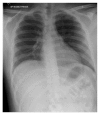Human Infection with Fusobacterium necrophorum without Jugular Venous Thrombosis: A Varied Presentation of Lemierre's Syndrome
- PMID: 29204301
- PMCID: PMC5674496
- DOI: 10.1155/2017/5358095
Human Infection with Fusobacterium necrophorum without Jugular Venous Thrombosis: A Varied Presentation of Lemierre's Syndrome
Abstract
Lemierre's syndrome is also known as postangina septicemia, which is commonly caused by Fusobacterium necrophorum also known as Necrobacillus and also by other microorganisms like Staphylococcus, Streptococcus, Peptostreptococcus, and Bacteroides. Though the disease starts as an upper respiratory tract infection, it may spread and cause thrombophlebitis of the internal jugular vein. It may present itself through cranial nerve palsy or sepsis involving distant organs like the lungs or bones. It is also known as forgotten disease because of its rarity. Fusobacterium necrophorum usually causes infection in animals and rarely affects humans. We hereby present a case of Necrobacillus infection which did not cause any thrombophlebitis but resulted in severe pneumonia and acute kidney injury, leading to respiratory failure and requiring mechanical ventilation.
Figures




References
Publication types
LinkOut - more resources
Full Text Sources
Other Literature Sources

